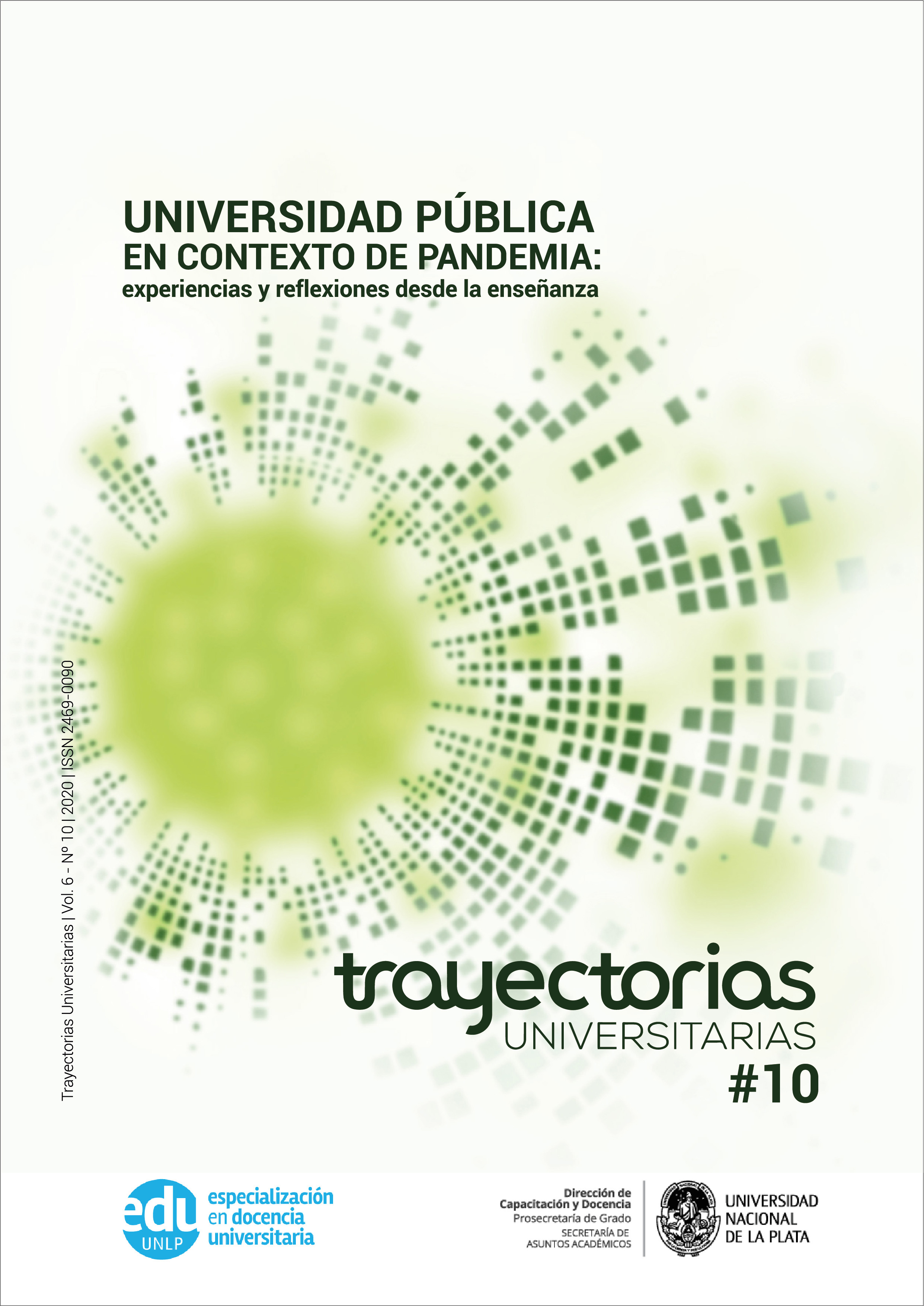Possibilities and limitations of the Practice Path in times of Pandemic. The case of the UNR Faculty in Mathematics
DOI:
https://doi.org/10.24215/24690090e024Keywords:
Teaching staff in Mathematics, Professional Teaching Practice, Virtualization, PandemicAbstract
This paper is located in the development of the teaching practice path in the context of the pandemic of the year 2020, taking as a case the Faculty in Mathematics of the National University of Rosario. This university, as well as others in the national territory, has chosen to approach a pedagogy of virtualization during the period of isolation. For the career in question, the path of teaching practice constitutes its articulating project, as it is developed intentionally and comprehensively from the first to the fourth and last year of the study plan. In this framework, the present work takes up testimonies of teachers from the respective curricular spaces. Specifically, the teachers share opinions and experiences regarding both the similarities and the differences with respect to the classroom in social, technological, institutional and content terms. They also mention difficulties they are having in this context and, in turn, point out aspects that could be enhancing themselves compared to what usually happens in the classroom. Finally, they identify limitations inherent in virtuality for the development of the path of interest, without ceasing to point out possibilities that in these circumstances are emerging. These situated reflections allow to strengthen the knowledge about the adaptations of the training devices to be a teacher in Mathematics that are used in the career. An understanding of the matter from educational research makes it possible not only to respond to the current situation, but also to continue improving the mechanisms to contribute to society with qualified professionals, with tools to decipher the needs of their time, in the key of university social commitment.
KEY WORDS: Teaching staff in Mathematics, Professional Teaching Practice, Virtualization, Pandemic.
Downloads
Metrics
References
Ball, D., Thames, M. & Phelps, G. (2008). “Content Knowledge for Teaching. What Makes It Special?”. Journal of Teacher Education, 59(5), 389-407.
Bartolomé, A. (2004). “Blended Learning. Conceptos básicos. Píxel-Bit”. Revista de Medios y Educación, (23), 7-20.
Consejo Interuniversitario Nacional (2013). Propuesta de Estándares para la Acreditación de los Profesorados Universitarios en Ciencias Exactas y Naturales (Res.CIN856/13). Buenos Aires, Argentina: Autor.
Copertari, S. y Trottini, A.M. (2013). “Experiencia a distancia Universitarias sin distancia. Hacia una pedagogía de la virtualización”. En S. Copertari y S. Morelli (Comp.) (2013). Experiencias Universitarias de Enseñanzas a Distancia: Praxis, visiones y horizontes (pp.53-81). Rosario, Argentina: Laborde.
Davini, M.C. (2015). “La formación en la práctica docente”. Buenos Aires, Argetina: Paidós.
Edelstein, G. (2015). “La enseñanza en la formación para la práctica”. Educación, Formación e Investigación, 1(1), 1-11.
Eisner, E. (1998). “El ojo ilustrado. Indagación cualitativa y mejora de la práctica educativa”. Buenos Aires, Argentina: Paidós.
Gerlero, C.A. (2014). “Los sentidos del compromiso social universitario. Una aproximación a la construcción del estado del arte”. Revista de la Escuela de Ciencias de la Educación, (9), 129-146.
González, F. (2000). “Los Nuevos Roles del Profesor de Matemática. Retos de la Formación de Docentes para el Siglo XXI”. Paradigma, 21(1), 139-172.
Kemelmajer, C. (09/04/2020). “Educación en tiempos de pandemia: consejos de especialistas para enriquecer las aulas virtuales”. CONICET. Recuperado de: https://www.conicet.gov.ar/educacion-en-tiempos-de-pandemia-consejos-de-especialistas-para-enriquecer-las-aulas-virtuales/
Mishra, P. y Koehler, M. (2006). “Technological pedagogical content knowledge: A framework for teacher knowledge”. Teachers College Record, 108(6), 1017-1054.
Maggio, M. (2012). “Enriquecer la enseñanza. Los ambientes con alta disposición tecnológica como oportunidad”. Buenos Aires, Argentina: Paidós.
Reimers, F.M. (08/05/2020). “El COVID-19 y la educación del futuro”. Proyecto Educar 2050. Recuperado de https://www.kaltura.com/index.php/extwidget/preview/partner_id/1633051/uiconf_id/42959361/entry_id/1_pn8nrtrb/embed/iframe?
Sanjurjo, L. (2005). “Volver a empezar. En L. Sanjurjo y X. Rodríguez”. Volver a pensar la clase. Las formas básicas de enseñar (pp.11-138). Rosario, Argentina: Homo Sapiens.
Sanjurjo, L. (2009). “Razones que fundamentan nuestra mirada acerca de la formación de las prácticas”. En L. Sanjurjo (Coord.). Los dispositivos para la formación en las prácticas profesionales (pp.15-40). Rosario, Argentina: Homo Sapiens.
Downloads
Published
How to Cite
Issue
Section
License
La aceptación de un original por parte de la revista implica la cesión no exclusiva de los derechos patrimoniales de los/as autores/as en favor del editor, quien permite la reutilización, luego de su edición (postprint), bajo una Licencia Creative Commons Atribución-NoComercial-CompartirIgual 4.0 Internacional (CC BY-NC-SA 4.0).
Acorde a estos términos, el material se puede compartir (copiar y redistribuir en cualquier medio o formato) y adaptar (remezclar, transformar y crear a partir del material otra obra), siempre que a) se cite la autoría y la fuente original de su publicación (revista y URL de la obra), b) no se use para fines comerciales y c) se mantengan los mismos términos de la licencia.
La cesión de derechos no exclusivos implica que luego de su edición (postprint) en Trayectorias Universitarias los/as autores/as pueden publicar su trabajo en cualquier idioma, medio y formato; en tales casos, se solicita que se consigne que el material fue publicado originalmente en esta revista.
Tal cesión supone, también, la autorización de los/as autores/as para que el trabajo sea cosechado por SEDICI, el repositorio institucional de la Universidad Nacional de La Plata, y sea difundido en las bases de datos que el equipo editorial considere adecuadas para incrementar la visibilidad de la publicación y de sus autores/as.
Asimismo, la revista incentiva a los/as autores/as para que luego de su publicación en Trayectorias Universitarias depositen sus producciones en otros repositorios institucionales y temáticos, bajo el principio de que ofrecer a la sociedad la producción científica y académica sin restricciones contribuye a un mayor intercambio del conocimiento global.





















